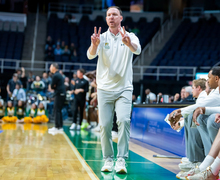Author speaks to SU community about creating positive change in toxic urban settings
Sam Ogozalek | Staff Writer
Shawn Ginwright stands in front of a PowerPoint presentation displaying a photo of a playground lit on fire by kids in the San Francisco neighborhood Bayview-Hunters Point. The neighborhood experiences a large amount of violence, the associate professor said during his Thursday presentation in Maxwell Hall.
Shawn Ginwright began by asking permission. Permission to talk from his heart, soul and mind — rather than read from a script.
“I think that when we’re able to connect our head and our hearts that something more beautiful can happen. And so I ask you for your permission,” said Ginwright, an associate professor of education in San Francisco State University’s Africana studies department.
Also an author whose work includes “Hope and Healing in Urban Education” and “Black Youth Rising,” Ginwright spoke at Syracuse University’s Maxwell School of Citizenship and Public Affairs Thursday evening to kick off this year’s Douglas Biklen Landscape of Urban Education Lecture Series.
The lecture series, sponsored by SU’s School of Education and the SU Humanities Center, is a forum for different perspectives, discussions and information on the current state of urban education in America. The series was created in 2005.
“One of the most insidious forms of injustice is its eroding of our sense of hope and possibility,” Ginwright said.
Nods with muffled murmurs of assent and agreement frequently met his words in the crowd totaling nearly 150 students, faculty and educators in Maxwell Hall.
Ginwright’s presentation was primarily based on the tactics and ideas needed in urban schools and communities to successfully prevent hopelessness, social toxicity and structural violence. Ginwright had a focus on children, particularly black youth, in urban public school districts with large amounts of violence — especially gun violence — throughout most of his remarks.
The promotion and ability to sustain hope and healing, while reaching out to members of the community to build relationships, is the most effective way to create positive change in toxic urban settings, Ginwright said.
He used an example from the eastern portion of the San Francisco Bay Area to explain his point regarding the power of building relationships.
Hooked up to a projector, Ginwright flipped through slides describing the Office of Neighborhood Safety, a community initiative in Richmond, California. For years Richmond had the highest rate of homicides in the Bay Area despite being a small city, Ginwright said.
In 2005, SFGATE.com reported that four Richmond City Council members wanted to declare “a state of emergency” in the city due to the large amount of gun violence. The city and its police department was “scratching their heads,” and ended up spending millions of dollars hiring more police officers in an attempt to deal with the violence, to no effect, Ginwright said.
Eventually out of money the city turned to DeVone Boggan, who launched the Office of Neighborhood Safety in 2007, Ginwright said.
Boggan broached a radical idea: pay people to not shoot one another.
Only 12 young men were responsible for 80 percent of Richmond’s homicides at the time, Ginwright said. Boggan suggested “wrapping their arms” around the 12 young men, supporting, paying and getting to know them.
“I heard that they were building love and relationships with boys that shoot at each other,” Ginwright said, referring to the Office of Neighborhood Safety. “And I was like, what does that mean?”
In his speech Thursday, Ginwright recalled meeting with Boggan and traveling with neighborhood safety employees to better understand the non-law enforcement agency tasked with reducing gun violence.
“In 2009, there were about 45 homicides in that (area). And then, when I wrote the book (“Hope and Healing in Urban Education”), which was two years ago, they had brought down the homicide rate below 15 — it was 13 homicides,” Ginwright said. “(Richmond) hadn’t seen this type of reduction in homicides in 30 years.”
Love and relationships have the ability to transform neighborhoods and communities, he added.
Aside from encouraging the ability to build relationships in urban communities, Ginwright also said there needs to be new training for school teachers and principals, along with new policies and additional streams of funding to ensure urban schools are recognized not just as places as learning but as places of well-being. Ginwright also discussed other examples of emotional support that could help curb violence in urban communities and increase a sense of unity.
Ginwright’s willingness to discuss love, emotions and the need for healing and hope in urban education and communities was well-received by the crowd. During a brief Q&A following his presentation, audience members praised Ginwright for speaking about topics they said are rarely discussed.
Following Ginwright’s remarks, Syracuse city school board member Mark Muhammad, who attended the event, discussed his take on the presentation in an interview with The Daily Orange.
“I think that the conversation that he is trying to introduce is one that is very much needed,” Muhammad said. “Right, the one about hope and healing … I think it’s really important. But we have to have the courage to take a new direction and to try those kind of things.”
Published on September 23, 2016 at 12:41 am
Contact Sam: sfogozal@syr.edu | @SamOgozalek





